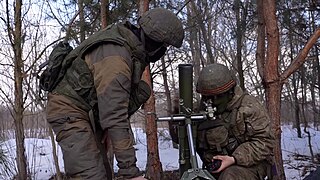
Belgorod Oblast is a federal subject of Russia. Its administrative center is the city of Belgorod. As of 2021, the population is 1,540,486.

Luhansk Oblast, also referred to as Luhanshchyna (Луга́нщина), is the easternmost oblast (province) of Ukraine. Its administrative center is the city of Luhansk. The oblast was established in 1938 and bore the name Voroshilovgrad Oblast until 1958 and again from 1970 to 1991. It has a population of 2,102,921.

Dragon's teeth are pyramidal anti-tank obstacles of reinforced concrete first used during the Second World War to impede the movement of tanks and mechanised infantry. The idea was to slow down and channel tanks into killing zones where they could easily be disposed of by anti-tank weapons.

Russian separatist forces in Ukraine, primarily the People's Militias of the Donetsk People's Republic (DPR) and the Luhansk People's Republic (LPR), were pro-Russian paramilitaries in the Donbas region of eastern Ukraine. They were under the overall control of the Russian Federation, and were also referred to as Russian proxy forces. They were active during the war in Donbas (2014–2022), the first stage of the Russo-Ukrainian War. They then supported the Russian Armed Forces against the Ukrainian Armed Forces during the 2022 Russian invasion. In September 2022, Russia annexed the DPR and LPR, and began integrating the paramilitaries into its armed forces. They are designated as terrorist groups by the government of Ukraine.

RT France, also known as RT en français, was the French version of the Russian state-controlled news channel RT. The channel was based in the Paris suburb of Boulogne-Billancourt and was funded by the Russian government.

Sergey Vladimirovich Surovikin is a Russian army general who serves as head of the Coordinating Committee for Air Defence under the Council of Defence Ministers of the Commonwealth of Independent States (CIS) since September 2023.

The Wagner Group, officially known as PMC Wagner is a Russian state-funded private military company (PMC) controlled until 2023 by Yevgeny Prigozhin, a former close ally of Russia's president Vladimir Putin. The Wagner Group has used infrastructure of the Russian Armed Forces. Evidence suggests that Wagner has been used as a proxy by the Russian government, allowing it to have plausible deniability for military operations abroad, and hiding the true casualties of Russia's foreign interventions.

The 56th Motorized Brigade is a formation of the Ukrainian Ground Forces. The brigade was activated on 23 February 2015 in the city of Dnipro in Dnipropetrovsk Oblast and took command of three volunteer territorial defence battalions. The brigade fought in the Russo-Ukrainian War and has functioned as a motorized brigade.

Dmitry Valerievich Utkin was a Russian military officer and mercenary. He served as a special forces officer in the GRU, where he held the rank of lieutenant colonel. He was the co-founder and military commander of the Russian state-funded Wagner Group, with his military alias reportedly being Wagner. Utkin was reportedly a neo-Nazi. He rarely made public appearances, but was allegedly the commander of the private military company, while Yevgeny Prigozhin was its owner and public face. Utkin was awarded four Orders of Courage of Russia.

Novopskov is an urban-type settlement in the Starobilsk Raion of Luhansk Oblast in Ukraine. It is located on the Aidar, a left tributary of the Donets, in the basin of the Don. Population: 9,392 Prior to 2020, it was the administrative centre of the former Novopskov Raion.

Ukraine's easternmost oblasts, Donetsk, Luhansk, and Kharkiv, are the site of a theatre of operation in the ongoing Russian invasion of Ukraine.

The town of Borodianka was bombed extensively by the Russian Armed Forces during the Russian invasion of Ukraine.
Several attacks in mainland Russia, primarily in the Bryansk, Kursk, and Belgorod oblasts, have been reported since the start of the Russian invasion of Ukraine, which began on 24 February 2022. Russia accused Ukraine of being responsible for these attacks.
The torture of Russian soldiers in Mala Rohan was an incident during the 2022 Russian invasion of Ukraine that occurred in the village of Mala Rohan. As documented by the UN High Commissioner for Human Rights, members of Ukrainian armed forces shot the legs of three captured Russian soldiers and tortured Russian soldiers who were wounded. The incident is likely to have occurred on the evening of March 25, 2022 and was first reported following the publication on social media of a video of unknown authorship between March 27 and March 28. As a case of summary execution and torture of prisoners of war, the incident might qualify as a war crime.

Oleksiy Opanasovych Vadaturskyi was a Ukrainian agricultural and grain logistics businessman and the founder of Nibulon, the largest grain logistics company in Ukraine. He was one of the wealthiest Ukrainians.

Since 19 September 2022, a military campaign has taken place along a 60-km frontline in western parts of Luhansk Oblast and far-eastern parts of Kharkiv Oblast amid the Russian invasion of Ukraine. Also known as the Svatove–Kreminna line or the Kupiansk–Svatove–Kreminna–Bilohorivka line after the major settlements along the front, the campaign began a day after the Ukrainian Army recaptured the nearby city of Lyman during the Kharkiv counteroffensive after of which the front line froze over the next few months.

Yevgeny Anatolyevich Nuzhin was a convicted Russian murderer who enlisted in Wagner Group during the 2022 Russian invasion of Ukraine.
This timeline of the Russian invasion of Ukraine covers the period from 12 November 2022, following the conclusion of Ukraine's Kherson and Kharkiv counteroffensives, to 7 June 2023, the day before the 2023 Ukrainian counteroffensive began. Russia continued its strikes against Ukrainian infrastructure while the Battle of Bakhmut escalated.
The Wagner Group, also known as PMC Wagner, a Russian paramilitary organization also described as a private military company (PMC), a network of mercenaries, and a de facto unit of the Russian Ministry of Defence (MoD) or Russia's military intelligence agency, the GRU, has conducted operations in Ukraine since early 2014.
Trauma has affected military veterans and civilian populations exposed to the Russian invasion of Ukraine.














